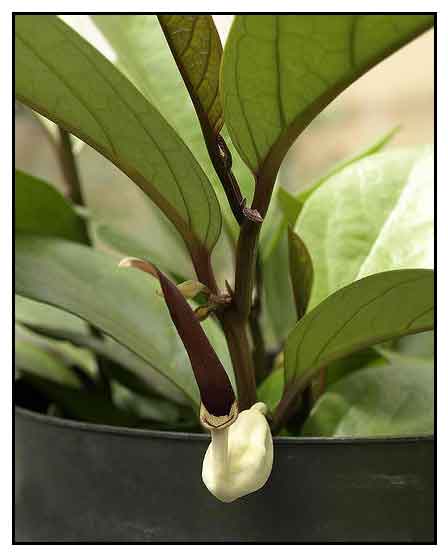 Gen info Gen info
- There are about 500 species in the Aristolochiaceae family. Most of the common ones are vines known as "Dutchman's pipe" referring to the unusual shape of the flowers that characterize the genus.
- Aristolochia species have medicinal properties known to ancient Greek, Roman, Egyptian, and Chinese nedicine.
However, the genus is also known for the lethal toxin aristolochic acid. (see study below)
- Aristolochia species are the larval food of swallowtail butterflies. It has been assumed that the North American pipevine swallow tail, Battus philenor is protected from its natural enemies by aristolochic acids sequestered from Aristolochia food plants. (4) (5)
Botany
Barubo is a low, shrubby, smooth plant, attaining a height of 1 meter or more. Leaves are oblong or oblong-elliptic, 14 to 21 centimeters long, 3.5 to 7 centimeters wide, with obtuse base and tapering pointed apex. Fruit is obovoid or oblong-obovoid, 2 to 2.5 centimeters long. The species differ from Aristolochia tagala in the shape of the leaves and in having a smaller fruit.
An erect shrubby plant up to about 1 m tall, with terete old stems up to 4 cm in diameter, slightly irregularly ridged, and slightly striate branches. Leaves elliptical, lanceolate to oblanceolate, 8.5-24 cm by 3.5-8.5 cm, obtuse, sometimes slightly cuneate at the base, usually glabrous on both surfaces, with 1 pair of faint basal veins 5-8 pairs of secondary veins and loosely tertiary veins. Flowers in a spicate or racemose inflorescence, perianth 1-lipped, distinctly veined. Fruit subglobose, shortly cylindrical to oblong-ellipsoidal, up to 2.5 cm long. Seeds not winged. (6)
Distribution
- Endemic species.
- In thickets at low and medium altitudes, ascending up to 900 meters, in Cagayan, Isabela, Ilocos Norte, Ifugao, Benguet, Pangasinan, Zamales, Rizal, Quezon, Laguna, and Sorsogon Provinces in Luzon; in Palawan; Bancalan; and Negros.
Constituents
- Yields aristolochic acid. (see studies below) (1) (2)
Properties
- Roots considered stomachic, emmenagoguem carminative, febrifuge.
- Reported toxicity of aristolochic acid constituent. (see studies below)
Aristolochic acid toxicity concerns
- Aristolochic acids are a family of carcinogenic, mutagenic, and nephrotoxic phytochemicals commonly found in the flowering plant of family Aristolochiaceae. Aristolochic acid I is the most abundant one. (7)
- Plants containing aristolochic derivatives raise concerns on its potential toxicity, aristolochic acid nephropathy, and cautions on the traditional uses of the plant.
Parts used
Roots.
Uses
Folkloric
- Decoction of roots used by Filipinos to relieve stomachache and promote menstruation.
- Roots used as abortive, as uterine tonie, and for gastralgia.
Studies
• Aristolochic Acid: Analysis of South-East Asian troidine swallowtails showed high variability in the content of aristolochic acids among individuals. One plant specie, Aristolochia philippensis, a food plant source for the larvae, contained a high concentration of aristolochic acids. Whether the aristolochic acid provides a function in the chemical defense of the swallowtails is still an open question. (1) In one report, only one plant species, Aristolochia philippinensis, contained high concentration of aristolochic acids, while other species from various localities contained none or only marginal amounts. (5)
• Aristolochic Acid / Nephrotoxic: The more than 100 cases of nephropathy reported from the use of Chinese snakeroot (Aristolochia fangchi) highlights the risk of using preparations containing aristolochic acid, of which the Philippine specie contains a high concentration of. This study systematically assessed the scientific literature available on the local and traditional uses of Aristolochia spp. worldwide. (2)
• Aristolochic Acid / Toxicity Study: In a 1970 study, mice treated with aristolochic acid 1, the acute toxic manifestations were tachycardia, increases respiratory rate, ataxia, sedation and marked vasodilation. Short-term chronic toxic effects included hepatotoxicity, marked renal damage and mild hematologic dyscracias.
• Aristolochic Acid Nephropathy: Aristolochic acid nephropathy, a progressive renal interstitial fibrosis, was reported in more than 100 patients after taking a Chinese herb, Aristolochia fangchi. Another report of a series of more than 2000 Indian patients from a population that used more than 7500 plant species raises the question that some of them could be related to Aristolochia species, including A bracteata, A tagala and A indica.
Availability
Wild-crafted.
|

![]()



 Gen info
Gen info